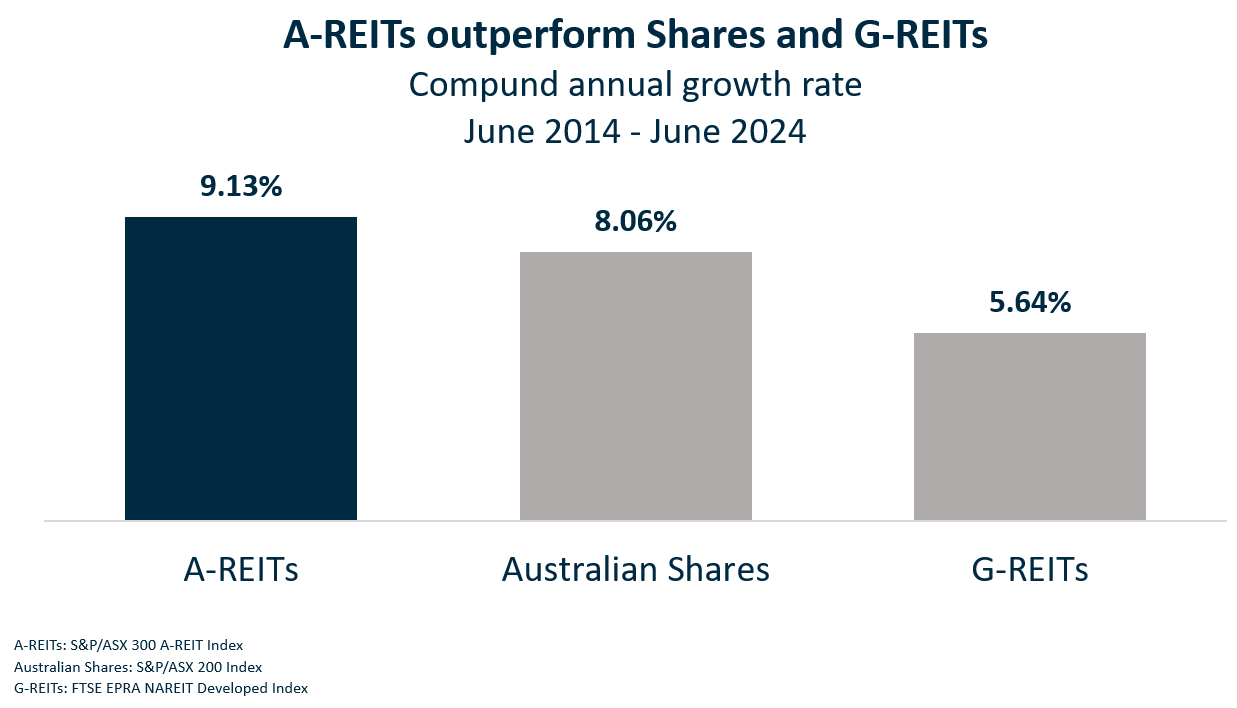A-REIT vs G-REIT - It’s a case of quality over quantity
Summary: Despite greater diversification and a global set, Australian REITS “A-REITS” have historically outperformed their global peers “G-REITS”. There are many reasons for this including industry structure, asset quality, experienced management, and proven operating models. We believe this trend will continue, however investors need to be selective given the changing interest rate environment and variation in factors such as capital strength and asset quality. When it comes to portfolio construction, it’s a case of quality over quantity with the higher quality A-REITS, particularly those in structurally favourable sectors likely to generate significant long-term outperformance.
After a sustained period of falling cash rates and a low interest rate environment, the rapid rise in inflation and spiking interest rates over 2022 to 2023 had a significant impact on the performance of REITs (Real Estate Investment Trusts) globally. REITs were hit with a myriad of issues from rising construction costs exacerbated by supply chain disruptions and labour shortages to high costs of capital, which eroded earnings and constrained growth. But not all REITS were equally affected, giving rise to a significant divergence in returns. Those with strong capital management and high quality assets in sectors supported by structural trends such as data centres delivered strong returns, whilst others experienced declining earnings and distribution cuts.
As the cycle turns and we move into a more stable rate environment with the expectation of cuts later this year and next, pockets of value are emerging and attractive opportunities are likely to both broaden and accelerate. However, investors need to be selective in positioning portfolios now to capitalise on the positive outlook ahead.
A-REITs outperform G-REITs
A-REITs offer a compelling avenue for investors to access attractive asset-backed income streams and potential for capital growth, with better returns compared to G-REITs.
A-REITs have a strong history of delivering attractive returns. Over the past 10 years to 30 June 2024, they’ve averaged an impressive annual return of 9%, outperforming both the broader Australian share market (8%) and G-REITs (6%).

The success of A-REITs can be attributed to high asset quality, low leverage, and attractive yields.
High asset quality
One of the key characteristics of investing in REITs is the stable yield derived from contractual long-term leases to a diversified and quality tenant base, often large multi-national corporations. This income is highly dependent on asset quality, location and market fundamentals.
Take the office sector for example, which has been heavily affected by the working from home thematic over the past four years since the pandemic. This, along with the rising cost of debt, has placed downward pressure on property valuations and operating conditions such as occupancy, incentive levels and rental growth.
A-REITs predominantly hold premium/prime grade office portfolios. They have benefited from higher occupancies of over 90%, as large corporations and government tenants opt for less space but higher quality in terms of amenities and more sustainable buildings with better energy ratings. G-REITs on the other hand, tend to hold broader portfolios including exposure to secondary markets, such as in the US where there is an oversupply, and have been left behind amid the flight to quality. As a result, the vacancy rate for US office is as high as 20% compared to A-REIT office portfolios of under 10%. When we assess the longer-term recovery prospects of the office sector, A-REITs are also ahead with Australians returning to the office at a much faster rate of 76% pre-Covid levels whilst the US is lagging at around 50%.
Low leverage
The sharp rise in inflation and interest rates over the past two years, not only increased the cost of servicing debt but also reduced the ability to grow from acquisitions. In this environment, REITs with strong balance sheets are highly favoured as they are able to take advantage of opportunities to acquire assets at attractive bottom-of-the-cycle pricing and position for future growth (such as buying land from distressed residential developers).
Here too, A-REITs are in a strong position, with sector average gearing of only 27% compared to G-REITs of 40%. This means that the sharp rise in interest rates that has doubled the cost of debt has less of an impact on earnings for A-REITs than G-REITs. The already high gearing, compounded with sharp devaluations in assets as experienced by the office sector in this cycle, further increases LVRs (loan-to-value ratios) and the greater risk for G-REITs to breach debt covenants.
Attractive yields
REITs have historically provided reliable income returns for investors in the form of regular dividend payments. The composition of the income stream determines the payout ratio (i.e. dividend yield). Traditional “rent collectors” typically pay out close to 100% of income, whilst REITs with operating businesses have lower payout ratios as they reinvest capital back into the business for growth.
In the past 10 years, REITs have diversified into other asset classes such as childcare and data centres, and gained exposure to other income streams such as funds management and property development.
Today, the G-REIT Index is increasingly exposed to operational businesses such as residential developers (15%), hotels (6%) and self-storage (6%). The transformation of the sector is the greatest in the US, which makes up more than 60% of the G-REIT Index. This may partially explain the lower yield that G-REITs offer at around 4% compared to A-REITs at around 6%.
Addressing the elephant in the room
Even with its impressive return profile, A-REITs are often overlooked due to the concentration of the index (S&P/ASX 300 A-REIT Total Return Index). It consists of 33 stocks dominated by Goodman Group (GMG) making up 40% of the Index. Over the last decade, a surge in e-commerce supported strong demand for industrial space which has driven GMG’s outperformance. In May 2023, GMG announced its strategy to accelerate the development of data centres with a strong secured pipeline which sent the stock price skyrocketing, increasing its market capitalisation from 26% to 40% of the Index. We view GMG as an excellent company but one that needs to be actively managed as with a lot of growth stocks, can at times be overvalued. It is important to note that this is not the first time that a single stock has dominated the Index. In October 2008, Westfield comprised 58% of the Index.
In comparison, the G-REIT Index comprises of 359 stocks with 64% exposure to the US, 14% to Asia, 13% to Europe and 6% to Australia. G-REIT investors are also exposed to different levels of quality and risk profile; the US offers greater exposure to secondary markets and relatively poorer quality assets, Europe has a higher proportion of office park exposure, and Asian REITs are dominated by residential developers with relatively poor levels of disclosure. This is in contrast to the relatively passive earnings profile of A-REITs which typically hold Premium and A grade portfolios concentrated in prime capital Australian city locations.
In short:
- G-REITs offer a broader opportunity set but this comes with additional asset, earnings and operational risk.
- A-REITs offer better returns, generating attractive dividend yields from exposure to high quality assets without exposure to currency and geopolitical risks which adds to the complexities of managing G-REIT investments.
As a high conviction investor, we are benchmark unaware and look for opportunities outside the Index. In fact, our investable universe spans over 50 REITs and property companies with a preference for alternative real estate assets driven by secular trends such as childcare, healthcare, retirement living and data centres. When investing outside the Index and in alternative assets, we maintain the same level of discipline by focusing on management track record, balance sheet strength, asset quality, earnings certainty, tenant covenant and tangible asset backing.
As rates start to come down, we expect sentiment to be much more favourable for the REIT sector and believe there continues to be compelling opportunities for A-REIT investors.
5 topics

